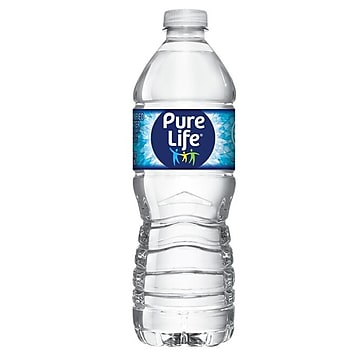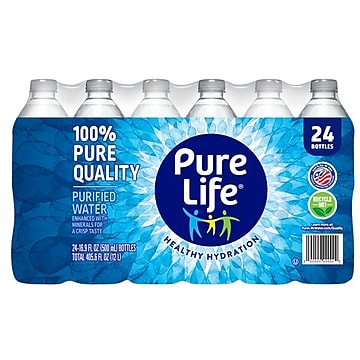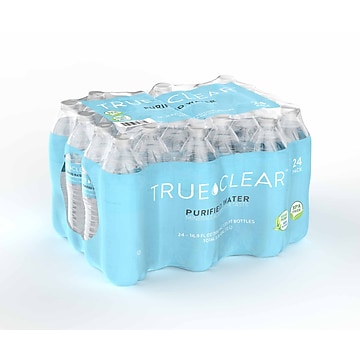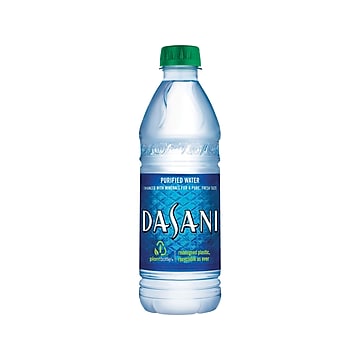Bottled Water for the Office Fridge
Best Match
Grid view
Pick up and Delivery
Brand
Sparkling or Still
Type of Water
Beverage Pack Size
Rating
Price
Choose bottled water to enjoy potable water wherever you go. Quick and convenient access to safe drinking water is important to staying hydrated. Single-serve bottles make it easier to carry drinking water everywhere, especially where clean tap water is unavailable. Keep the office breakroom stocked with cases of spring water and sparkling water and have them ready at home too. Browse the wide selection of beverages available at Staples to find different types and brands of bottled drinking water.
Choose from different types of bottled water
Besides plain water, companies also bottle other types of water in single-serve containers. The most popular ones are from natural sources. These include artesian, mineral, purified, spring water, and sparkling water. Artesian water comes from aquifers that act as natural filters for groundwater. Mineral water contains dissolved solids including minerals such as calcium, potassium, and magnesium. Spring water comes from underground sources that naturally flow to the surface.
Purified water is one that has its minerals removed by distillation, deionization, and/or filtration. It has a very high purity level and no residual taste. Sparkling water contains carbon dioxide that bottling companies may remove during treatment and reintroduce thereafter. Bottled water may also have added contents. Carbonated water is fizzy because of dissolved carbon dioxide added under pressure. Flavored water has a distinct taste added by infused flavors usually derived from fruits.
Consider size and container when shopping for bottled water
While there are other sizes, manufacturers commonly use these three standard bottle sizes: 8 ounces, 16.9 ounces, and 1 liter. Small 8-ounce bottles are the lightest and ideal for kids and events that serve other beverages. Choose this size if you intend to drink the content all at once and don’t want to carry around a bottle. Mid-sized 16.9-ounce bottles will satisfy deep thirsts and are suitable for hot days. Choose large 1-liter bottles to share with others or keep in the fridge.
Brands usually bottle water in plastic containers and cans. PET, or polyethylene terephthalate, is the preferred choice for single-serve use. It’s lightweight and break-resistant, and strong enough to withstand the pressure of carbonated drinks. Metal cans also offer these benefits. They usually come in 8.45-ounce and 12-ounce units. Manufacturers mostly use cans for sparkling and flavored water to differentiate them from their regular offerings. Cans also protect flavoring agents and other additives from direct sunlight.
Does bottled water expire?
No. Manufacturers put expiration dates on packaged water products because they’re consumable food products. While it may not taste as fresh, bottled potable water is safe to drink past its expiration date.
What is the pH of bottled water?
The Environmental Protection Agency (EPA) recommends that drinking water should have a pH value between 6.5 and 8.5. Water with a pH lower than 6.5 may taste bitter or metallic due to unsafe levels of chemical and/or heavy metal pollutants. While alkaline water is generally safe, a pH level above 8.5 gives water a distinct taste that many find unpleasant.
Should you worry about the BPA content of bottled water?
No. PET bottles don’t contain bisphenol A (BPA). Neither do they contain bisphenol S (BPS). Both compounds are common ingredients used for plastic containers and have possible health and environmental impacts.
Choose from different types of bottled water
Besides plain water, companies also bottle other types of water in single-serve containers. The most popular ones are from natural sources. These include artesian, mineral, purified, spring water, and sparkling water. Artesian water comes from aquifers that act as natural filters for groundwater. Mineral water contains dissolved solids including minerals such as calcium, potassium, and magnesium. Spring water comes from underground sources that naturally flow to the surface.
Purified water is one that has its minerals removed by distillation, deionization, and/or filtration. It has a very high purity level and no residual taste. Sparkling water contains carbon dioxide that bottling companies may remove during treatment and reintroduce thereafter. Bottled water may also have added contents. Carbonated water is fizzy because of dissolved carbon dioxide added under pressure. Flavored water has a distinct taste added by infused flavors usually derived from fruits.
Consider size and container when shopping for bottled water
While there are other sizes, manufacturers commonly use these three standard bottle sizes: 8 ounces, 16.9 ounces, and 1 liter. Small 8-ounce bottles are the lightest and ideal for kids and events that serve other beverages. Choose this size if you intend to drink the content all at once and don’t want to carry around a bottle. Mid-sized 16.9-ounce bottles will satisfy deep thirsts and are suitable for hot days. Choose large 1-liter bottles to share with others or keep in the fridge.
Brands usually bottle water in plastic containers and cans. PET, or polyethylene terephthalate, is the preferred choice for single-serve use. It’s lightweight and break-resistant, and strong enough to withstand the pressure of carbonated drinks. Metal cans also offer these benefits. They usually come in 8.45-ounce and 12-ounce units. Manufacturers mostly use cans for sparkling and flavored water to differentiate them from their regular offerings. Cans also protect flavoring agents and other additives from direct sunlight.
Does bottled water expire?
No. Manufacturers put expiration dates on packaged water products because they’re consumable food products. While it may not taste as fresh, bottled potable water is safe to drink past its expiration date.
What is the pH of bottled water?
The Environmental Protection Agency (EPA) recommends that drinking water should have a pH value between 6.5 and 8.5. Water with a pH lower than 6.5 may taste bitter or metallic due to unsafe levels of chemical and/or heavy metal pollutants. While alkaline water is generally safe, a pH level above 8.5 gives water a distinct taste that many find unpleasant.
Should you worry about the BPA content of bottled water?
No. PET bottles don’t contain bisphenol A (BPA). Neither do they contain bisphenol S (BPS). Both compounds are common ingredients used for plastic containers and have possible health and environmental impacts.








































































